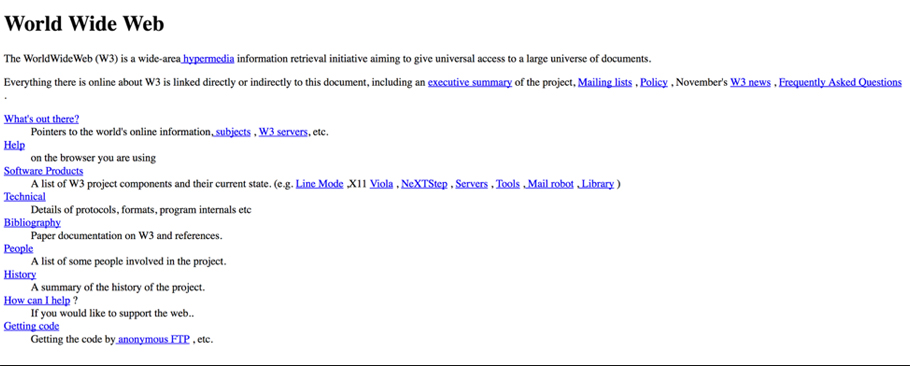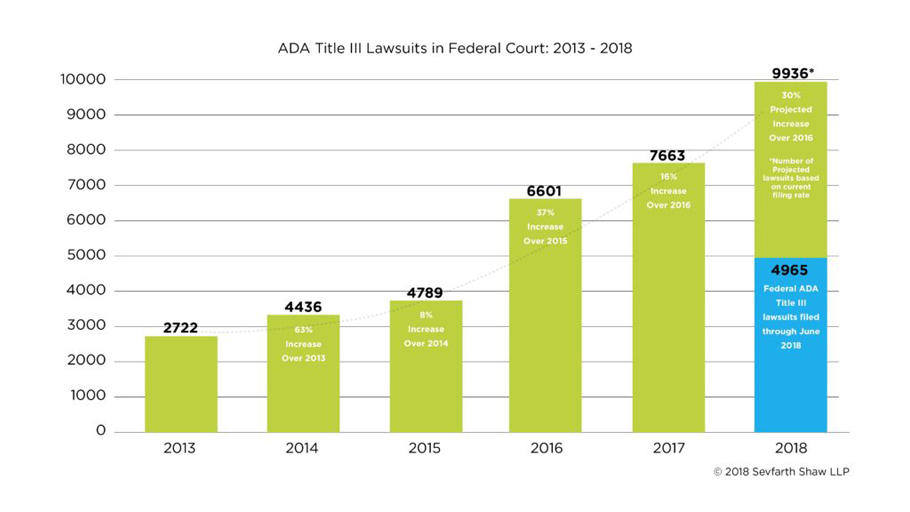The first website was launched by the CERN in Switzerland more than 27 years ago, and it looked like this:
Not too exciting by today’s standards, but with quantum leaps in design, technology and functionality, retail, entertainment and brand websites have been a fixture in our lives for at least 20 years. So deeply has the web penetrated how we navigate the world, that today your website could land you in court for a pretty unexpected reason.
Landmark legislation promotes equal access
In 1990, just one year before the CERN launched that first website, President George H.W. Bush signed the Americans with Disabilities Act (ADA) into law. This watershed bill was created to guarantee access for disabled Americans to everything from public buildings to retail stores and offices. Across the country, parking spaces, restroom facilities, wheelchair access ramps and dozens of other accommodations were created to grant better accessibility to those who previously had barriers to everyday life.
A growing wave of accessibility suits
Yet today, because of the aforementioned impact of the web on our lives, a wave of lawsuits is sweeping the country under Title III of the ADA asserting that many websites must offer accessibility for people with disabilities much like brick and mortar “accommodations” have been required for three decades. These lawsuits assert that websites must offer the same level of accessibility, for example, for people with impaired sight as they do for the sighted.
Clearly it makes sense today to incorporate accessibility into our websites in the interest of both fairness and offering excellent service to our customers. But with the growing number of digital accessibility lawsuits, now it makes good financial sense as well. According to international law firm Seyfarth Shaw, the number of ADA Title III lawsuits (including website accessibility suits) was nearly 10,000 in 2018 and has been trending upwards significantly since 2013.
Well known companies including Hooters, Domino’s, Winn-Dixie, GNC, Dave and Busters, and thousands of small and mid-sized businesses have been forced to recognize the importance of digital accessibility for their disabled customers, often after paying a substantial settlement to the person who filed the complaint or paying significant legal fees.
How do I know if my website meets ADA standards?
If you took part in having your website built and did not specify that it be built with accessibility in mind, it’s probably not very accessible. If you want to dig further into the subject of accessibility, you might want to ask the guy who invented the internet. Sir Tim Berners-Lee is credited with inventing the World Wide Web back in 1989 and heads the organization W3C . W3C, in collaboration with others, has created the Web Content Accessibility Guidelines (WCAG), now in version 2.1. WCAG sets out 38 success requirements for websites to meet their AA accessibility rating (the gold standard for accessibility). For more information on WCAG 2.1 you check out the WCAG requirements here or contact us for a free site review.
Should you add accessibility to your website?
In a word, probably. First, if you are a public or private institution that receives Federal funds of any kind – a university grant from NASA or the Department of Agriculture, Medicaid, etc., or are a public institution that is otherwise required to be compliant with Title II of the ADA, there is no doubt, you must update your web accessibility right away.
However, if you are a private business subject to Title III of the ADA, there are three great reasons why you should consider updating your website to WCAG 2.1:
- Good Business – Most companies who thrive do so because of their desire to offer excellent service to their customers or potential customers. According to the National Center for Health Statistics, the number of adults (18+ ) reported as being sight impaired (adults with vision loss) in 2016 was 25.5 Million. That means the number of people who may benefit from accessibility on your website is roughly 10% of the adult population in the US. And that’s only sight impaired disabilities. Can you afford to alienate 10% or more of your potential customers?
- Safety First – ADA Title III accessibility lawsuits are still a “complaint-driven” process, meaning that we still don’t know with certainty what will trigger a successful suit. The act itself is broadly written and the results of lawsuits vary, so you may not know if accessibility is a “requirement” for you until you’re actually sued. Meanwhile the cost of updating the average website to WCAG 2.1 compliance can ultimately be significantly lower than the potential legal fees if your business is one of the unlucky ones to be sued.
- Good Corporate Citizenship – It’s the right thing to do. Social norms in the US look dimly upon people and businesses that do not accommodate Americans with disabilities. This group often includes former military and the elderly, people who have clearly earned the right to our respect. Offering accessibility to potential customers, shows people a lot about the character of your company.
Is it hard to update my site for accessibility?
If you are creating a new site or replacing your old one, building your site to meet basic accessibility requirements does not need to add significant cost to your site build.
Ideally, if you are building a new site, your agency can help you plan in advance how you will build navigation, use text, images, video and forms to create a site that is easily optimized for accessibility.
If you are trying to retro-fit accessibility features to your existing site it can be a bit more challenging. Many sites are built to be attractive without taking accessibility into account, but a skilled agency web development team can help you achieve accessibility. While actual costs will vary based on how your site was built, adding in accessibility to an existing site will cost you more than accessibility costs when it’s baked into a new site build. So if you are considering adding WCAG 2.1 accessibility to your site, it may be cost effective and beneficial to your business to consider whether it’s time to update your site as a whole.
More information on ADA website accessibility
If you would like more information on the benefits and technical requirements of updating your site for accessibility, please contact us and we’ll be happy to help.




